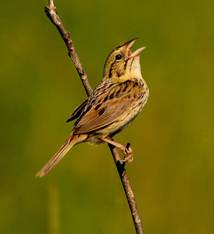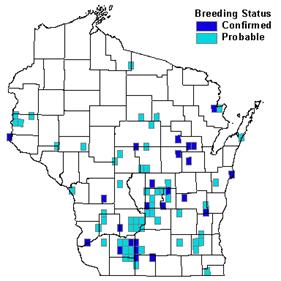Photo by Dennis Malueg


Status/Protection
- Global Rank: G4 Key to global and state ranks
- State Rank: S4B
- WBCI Priority: SGCN, PIF, State Threatened
Population Information
The Federal BBS information can be obtained at http://www.mbr-pwrc.usgs.gov/bbs/bbs.html by clicking on Trend Estimates and selecting the species in question. All estimates are for time period (1966-2005).
*Note: There are important deficiencies with these data. These results may be compromised by small sample size, low relative abundance on survey route, imprecise trends, and/or missing data. Caution should be used when evaluating this trend.
- Federal Breeding Bird Survey: significant decline
- Federal Breeding Bird Survey (WI): significant decline
- Federal Breeding Bird Survey (BCR 23): significant decline
- Federal Breeding Bird Survey (BCR 12): increase*
- WSO Checklist Project: significant u-shaped quadratic trend (1983-2007)
Life History
- Breeding Range: Southeastern Minnesota south to Oklahoma east to New York and Maryland; local breeding populations in other eastern states (Herkert et al. 2002).
- Breeding Habitat: Dry-mesic Prairie, Wet-mesic Prairie, Wet Prairie, Idle Cool-season Grasses, Idle Warm-season Grasses, Oak Opening, Southern Sedge Meadow and Marsh, Open Bog-Muskeg.
- Nest: Open cup in dense litter at base of grass clump.
- Nesting Dates: Eggs: late May to mid-July (Robbins 1991).
- Foraging: Ground glean.
- Migrant Status: Short-distance migrant.
- Habitat use during Migration: Large open fields or wetlands with lots of seeds (grasses and small grains).
- Arrival Dates: Late April to early May.
- Departure Dates: September.
- Winter Range: Southeast U.S. from east Texas east to Florida, north to Arkansas and east to North Carolina.
- Winter Habitat: Longleaf pine savannas, pitcher plant bogs, boggy pine flats.
Habitat Selection
Henslow’s Sparrows prefer grasslands with dense, grass-dominated vegetation of tall to moderate height, in either uplands or lowlands. Sample and Mossman (1997) classify Henslow’s Sparrow as a tall-grass species preferring medium to tall vegetation heights, dense litter, and significant residual vegetation in grass dominated fields with little to no woody cover. Typical habitats in Wisconsin include idle cool and warm season grasslands, poor fens in central Wisconsin, wet prairie, and larger oak openings. Nests are placed in thick litter at the base of a clump of grass usually slightly elevated from the ground. Henslow’s Sparrows are more likely to be encountered, and densities may be higher, in large grassland areas. Thus, large grasslands may be needed to support persistent populations (Herkert 1998, rev. 2001). Sample and Mossman (1997) list this species as moderately area-sensitive. In winter Henslow’s Sparrows are found in grass/sedge dominated pine savannas, pitcher plant bogs and other wet low areas.
Habitat Availability
Since Henslow’s Sparrows need dead standing grasses with a thick litter layer, most managed agricultural grasslands used by other grassland birds are not considered appropriate habitat. Almost all of the grassland habitat types used by Henslow’s Sparrows in Wisconsin are thought to be uncommon and vulnerable statewide (Sample and Mossman 1997). Since its inception in 1987, the Conservation Reserve Program (CRP) has created thousands of acres of unmanaged grasslands in Wisconsin, many of which provide excellent habitat for Henslow’s Sparrow.
Population Concerns
Henslow’s Sparrows, like many other grassland birds, are declining both locally and nationwide (Sauer et al. 2005). Henslow’s Sparrows are listed as threatened in Wisconsin and are prioritized by Partners in Flight (Rich et al. 2004) as a species of continental concern. This species apparently has been uncommon or locally common and irregularly distributed in Wisconsin at least since the last half of the nineteenth century. During the six-year period (1995-2000) of the Wisconsin Breeding Bird Atlas, Henslow’s Sparrows were recorded in only 8% of the Atlas quads (Sample 2006). Because the majority of the population probably exists on CRP fields on private land, its true population status is difficult to ascertain.
Major threats include loss or fragmentation of existing grassland habitat and intensifying management of agricultural grassland either through haying or grazing (Herkert et al. 2002). Nationally, CRP seems to have stabilized or increased populations (Herkert et al. 2002); however, BBS trends indicate continued declines in Wisconsin (Sauer et al. 2005). In addition, recent research suggests that Henslow’s Sparrows winter in high numbers in open pine savannas, a habitat type that has been severely impacted by forest succession, agriculture and development (Herkert et al. 2002). Until its preferred habitats of undisturbed tall grassland, as well as its wintering habitat in the Gulf States, are made secure as well as abundant, we may continue to see numbers of this sparrow fade (Sample 2002).
Recommended Management
A viable population of Henslow’s Sparrows in Wisconsin will depend upon continued large-scale grassland restoration and management within appropriate ecological landscapes (Sample and Mossman 1997, Knutson et al. 2001). Managers should seek to create large (>50ha, preferable 100ha), open grasslands with little to no woody vegetation (Herkert et al. 2003). Management should focus on providing tall vegetation with high amounts of litter (Sample and Mossman 1997, Knutson et al. 2001, Herkert et al. 2003). Henslow’s Sparrows do not use disturbed grasslands for one or two breeding seasons post-disturbance due to their requirement for litter and residual vegetation (Sample and Mossman 1997, Herkert et al. 2003). Individual grassland sites should be disturbed on relatively long rotations (4-6 years) or 20%-30% of a site in a given year (Herkert et al. 2003). Remove woody treelines or patches of forest that may fragment existing or potential Henslow’s Sparrow sites (Sample and Mossman 1997, Herkert et al. 2003).
Conservation and management strategies for this species should be focused in the following Wisconsins ecological landscapes: Southwest Savanna, Central Sand Hills, Central Sand Plains, Western Ridges and Coulees and Southeast Glacial Plains. Within these landscapes, key conservation sites include Buena Vista/Leola Grasslands, Horicon Marsh Refuge, Scuppernong Wet Prairie, Thompson grasslands, and many other publicly managed types of grassland.
Research Needs
Future monitoring efforts should focus on surveying suitable habitat on private lands to determine true distribution and population size for this secretive species. Research is needed to determine how management influences nesting success of this, and other grassland species (Herkert et al. 2002).
Information Sources
- Knutson, M.G., G. Butcher, J. Fitzgerald, and J. Shieldcastle. 2001. Partners in Flight Bird Conservation Plan for The Upper Great Lakes Plain (Physiographic Area 16). USGS Upper Midwest Environmental Sciences Center in cooperation with Partners in Flight. La Crosse, WI.
- Managing Habitat for Grassland Birds: A Guide for Wisconsin: http://www.npwrc.usgs.gov/resource/birds/wiscbird/
- North American Breeding Bird Survey: http://www.npwrc.usgs.gov
- Temple S.A., J.R. Cary, and R. Rolley. 1997. Wisconsin Birds; A Seasonal and Geographical Guide. Wisconsin Society of Ornithology and Wisconsin Department of Natural Resources, Madison, WI.
- Wisconsin Breeding Bird Atlas: http://www.uwgb.edu/birds/wbba/
- David Sample, Grassland Community Ecologist, Wisconsin DNR - 608-221-6351.
References
- Herkert, J.R. 2003. Effects of management practices on grassland birds: Henslow's Sparrow. Northern Prairie Wildlife Research Center, Jamestown, ND. Northern Prairie Wildlife Research Center Online. http://www.npwrc.usgs.gov/resource/literatr/grasbird/hesp/hesp.htm (Version 12DEC2003).
- Herkert, J.R., P.D. Vickery, and D.E. Kroodsma. 2002. Henslow’s Sparrow (Ammodramus henslowii). In The Birds of North America, No. 672 (A. Poole and F. Gill, eds.). The Birds of North America, Inc., Philadelphia, PA.
- Knutson, M.G., G. Butcher, J. Fitzgerald, and J. Shieldcastle. 2001. Partners in Flight Bird Conservation Plan for The Upper Great Lakes Plain (Physiographic Area 16). USGS Upper Midwest Environmental Sciences Center in cooperation with Partners in Flight. La Crosse, Wisconsin.
- Rolley, R.E. 2004. Wisconsin checklist project, 2000. Pp. 145-155 in B. Dhuey, ed. Wisconsin Wildlife Surveys: August 2001. Wisconsin Department of Natural Resources, Monona, WI.
- Sample, D. and M. Mossman. 1997. Managing Habitat for Grassland Birds: A Guide for Wisconsin. Wisconsin Department of Natural Resources: Madison, WI.
- Sample, D. 2006. Henslow’s Sparrow. In Atlas of the Breeding Birds of Wisconsin. (N.J. Cutright, B.R. Harriman, and R.W. Howe, eds.). The Wisconsin Society for Ornithology, Inc. 602pp.
- Sauer, J. R., J. E. Hines, and J. Fallon. 2005. The North American Breeding Bird Survey, Results and Analysis 1966 - 2004. Version 2005.2. USGS Patuxent Wildlife Research Center, Laurel, MD
Contact Information
- Compiler: Jenny Herrmann, mherrmann4@wi.rr.com
- Editor: Dave Sample, David.Sample@Wisconsin.gov | Kim Kreitinger, K.Kreitinger@gmail.com
